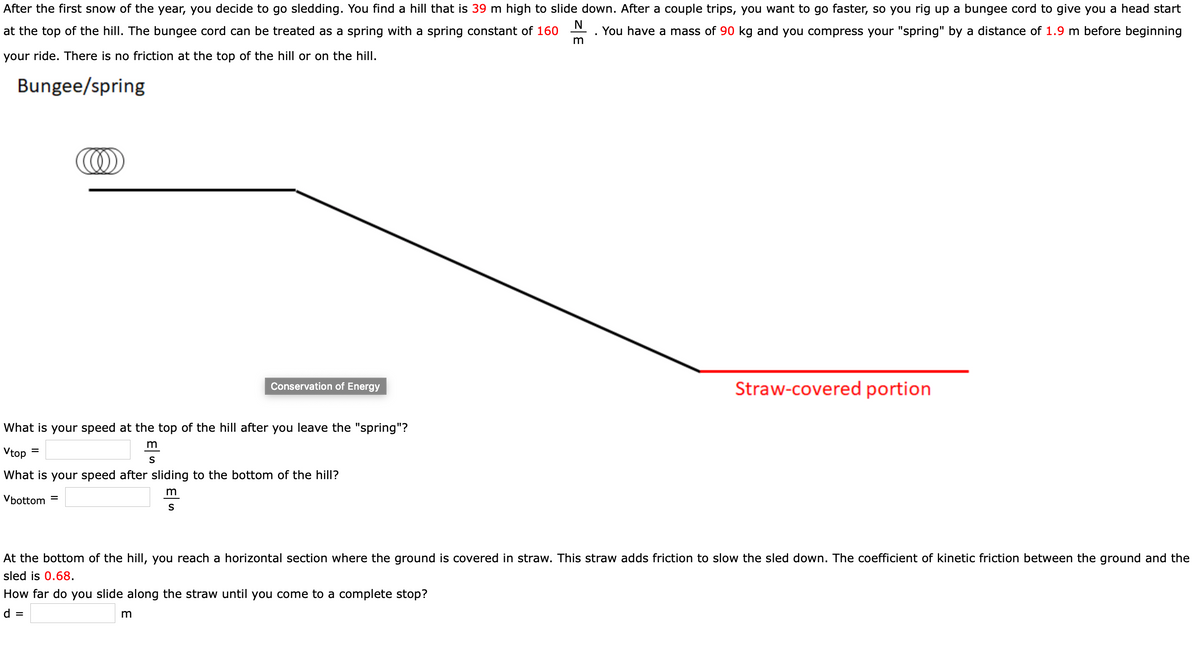After the first snow of the year, you decide to go sledding. You find a hill that is 39 m high to slide down. After a couple trips, you want to go faster, so you rig up a bungee cord to give you a head start at the top of the hill. The bungee cord can be treated as a spring with a spring constant of 160 N. You have a mass of 90 kg and you compress your "spring" by a distance of 1.9 m before beginning your ride. There is no friction at the top of the hill or on the hillI. Bungee/spring Conservation of Energy Straw-covered portion What is your speed at the top of the hill after you leave the "spring"? m Vtop = What is your speed after sliding to the bottom of the hill?
After the first snow of the year, you decide to go sledding. You find a hill that is 39 m high to slide down. After a couple trips, you want to go faster, so you rig up a bungee cord to give you a head start at the top of the hill. The bungee cord can be treated as a spring with a spring constant of 160 N. You have a mass of 90 kg and you compress your "spring" by a distance of 1.9 m before beginning your ride. There is no friction at the top of the hill or on the hillI. Bungee/spring Conservation of Energy Straw-covered portion What is your speed at the top of the hill after you leave the "spring"? m Vtop = What is your speed after sliding to the bottom of the hill?
Principles of Physics: A Calculus-Based Text
5th Edition
ISBN:9781133104261
Author:Raymond A. Serway, John W. Jewett
Publisher:Raymond A. Serway, John W. Jewett
Chapter7: Conservation Of Energy
Section: Chapter Questions
Problem 71P
Related questions
Question

Transcribed Image Text:After the first snow of the year, you decide to go sledding. You find a hill that is 39 m high to slide down. After a couple trips, you want to go faster, so you rig up a bungee cord to give you a head start
N
at the top of the hill. The bungee cord can be treated as a spring with a spring constant of 160
You have a mass of 90 kg and you compress your "spring" by a distance of 1.9 m before beginning
your ride. There is no friction at the top of the hill or on the hill.
Bungee/spring
Conservation of Energy
Straw-covered portion
What is your speed at the top of the hill after you leave the "spring"?
m
Vtop =
What is your speed after sliding to the bottom of the hill?
Vbottom =
S
At the bottom of the hill, you reach a horizontal section where the ground is covered in straw. This straw adds friction to slow the sled down. The coefficient of kinetic friction between the ground and the
sled is 0.68.
How far do you slide along the straw until you come to a complete stop?
d =
Expert Solution
This question has been solved!
Explore an expertly crafted, step-by-step solution for a thorough understanding of key concepts.
This is a popular solution!
Trending now
This is a popular solution!
Step by step
Solved in 4 steps with 4 images

Knowledge Booster
Learn more about
Need a deep-dive on the concept behind this application? Look no further. Learn more about this topic, physics and related others by exploring similar questions and additional content below.Recommended textbooks for you

Principles of Physics: A Calculus-Based Text
Physics
ISBN:
9781133104261
Author:
Raymond A. Serway, John W. Jewett
Publisher:
Cengage Learning

University Physics Volume 1
Physics
ISBN:
9781938168277
Author:
William Moebs, Samuel J. Ling, Jeff Sanny
Publisher:
OpenStax - Rice University

Physics for Scientists and Engineers: Foundations…
Physics
ISBN:
9781133939146
Author:
Katz, Debora M.
Publisher:
Cengage Learning

Principles of Physics: A Calculus-Based Text
Physics
ISBN:
9781133104261
Author:
Raymond A. Serway, John W. Jewett
Publisher:
Cengage Learning

University Physics Volume 1
Physics
ISBN:
9781938168277
Author:
William Moebs, Samuel J. Ling, Jeff Sanny
Publisher:
OpenStax - Rice University

Physics for Scientists and Engineers: Foundations…
Physics
ISBN:
9781133939146
Author:
Katz, Debora M.
Publisher:
Cengage Learning

Physics for Scientists and Engineers with Modern …
Physics
ISBN:
9781337553292
Author:
Raymond A. Serway, John W. Jewett
Publisher:
Cengage Learning

Physics for Scientists and Engineers
Physics
ISBN:
9781337553278
Author:
Raymond A. Serway, John W. Jewett
Publisher:
Cengage Learning

Physics for Scientists and Engineers, Technology …
Physics
ISBN:
9781305116399
Author:
Raymond A. Serway, John W. Jewett
Publisher:
Cengage Learning